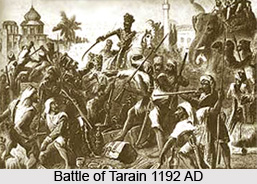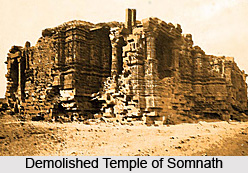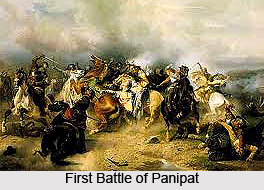 The overseas trade of the Arab and the Semitic people with India dates back to the pre-historic period. With the conversion of the Arabs into Islam, this trade was further magnified and integrated. Two new Indian customs: that the Hindus must not cross the salt-water and that they should not travel overland into countries where the munja-grass does not grow and the black gazelles do not graze, practically handed over all foreign commerce, along with the domestic commerce incidental to it, entirely to outsiders. To name a few commodities only, India needed Arab horses and Persian Gulf pearls, while foreign countries needed Indian sugar, silk, textiles and the Indian sword. Arab merchants had a free-run of the country and received a warm welcome from the several ruling realms, especially from the Rashtrakutas (AD 753-973). In most of the larger towns of the Deccan and South India, the `Mussalmans` (Muslims) were allotted plots of land in the suburbs of the cities for their residential houses, godowns, mosques and graveyards. In this rather unique manner happened the early Muslim advent into India, perhaps an inevitable portion in Indian history.
The overseas trade of the Arab and the Semitic people with India dates back to the pre-historic period. With the conversion of the Arabs into Islam, this trade was further magnified and integrated. Two new Indian customs: that the Hindus must not cross the salt-water and that they should not travel overland into countries where the munja-grass does not grow and the black gazelles do not graze, practically handed over all foreign commerce, along with the domestic commerce incidental to it, entirely to outsiders. To name a few commodities only, India needed Arab horses and Persian Gulf pearls, while foreign countries needed Indian sugar, silk, textiles and the Indian sword. Arab merchants had a free-run of the country and received a warm welcome from the several ruling realms, especially from the Rashtrakutas (AD 753-973). In most of the larger towns of the Deccan and South India, the `Mussalmans` (Muslims) were allotted plots of land in the suburbs of the cities for their residential houses, godowns, mosques and graveyards. In this rather unique manner happened the early Muslim advent into India, perhaps an inevitable portion in Indian history.
There happened, simultaneously, the advent of early Muslim traders from the north into India. Sind, conquered by Muhammad bin Qasim, broke away from the caliphate and was turned by the Ismailis or the Carmathian heretics into an indigenous Indian kingdom. The far-flung campaigns of Sultan Mahmud would have been impossible without an accurate knowledge of trade-routes and local resources, which was probably obtained from Muslim merchants. But, the mass of the immigrants arrived after Sultan Mahmud. Historians regret that the invasions of Sultan Mahmud had incited such a hatred in the Hindu heart as to make any intellectual intercourse between the two people difficult and soon after Mahmud`s death the Ghaznavid officers were driven back to the Ravi.
During these two centuries Ajam (an ancient place in erstwhile Persia) was thrice invaded, plundered and ransacked by Turkish tribes from the east. First, during the later days of Sultan Mahmud and his son, Mas`ud, the Seljuq Turkomans plundered the whole land and Sultan Mas`ud himself fled to India for safety along with his father`s treasures. These treasures were thus later re-scattered in the land of their origin. There must have occurred massive immigration of the Mussalmans (Muslims) into Punjab during this period. The early advent of Muslims into India were not only restricted to trade and business, but also, as is always known, through overpowering and battles.  The consolidation of the Seljuq Empire (AD 1037-1157) on a civilised basis probably stopped this immigration, but a century later conditions worsened again. The last days of Sultan Sanjar witnessed the establishment of the Qara-Khita power in Turkistan. In 1154 A.D. Sanjar himself was captured by the Ghuzz Turks, who carried him about in a cage while they pillaged Persia and Afghanistan, district by district. This started a second great wave of immigration into India. One of these immigrants was the mystic, Shaikh Ali Hajweri, author of the Kashful Mahjub, who lies buried in Lahore.
The consolidation of the Seljuq Empire (AD 1037-1157) on a civilised basis probably stopped this immigration, but a century later conditions worsened again. The last days of Sultan Sanjar witnessed the establishment of the Qara-Khita power in Turkistan. In 1154 A.D. Sanjar himself was captured by the Ghuzz Turks, who carried him about in a cage while they pillaged Persia and Afghanistan, district by district. This started a second great wave of immigration into India. One of these immigrants was the mystic, Shaikh Ali Hajweri, author of the Kashful Mahjub, who lies buried in Lahore.
The early Muslim advent into India first was headed towards Punjab and from there they slowly spread into the territories of the Hindu rais. India, on the other hand, had always been tolerant towards culture-groups and Muslim immigrants were allowed to organise their own small culture-groups without further harassment. They traded amongst each other and with the Hindus; and the Muslims probably brought into the country industries that were previously unheard of, specially the heavy-armament industry. When Muhammad bin Qasim, for instance, invaded Sind, he had the exclusive monopoly of catapults (munjaniqs), the creation of which the Mussalmans (Muslims) had learnt from the Romans. But by the end of the twelfth century the fort of every rai was plentifully supplied with munjaniqs and munjaniq-stones and the armies of most Indian rais had a Muslim contingent. It would not be an unfair assumption that these catapults (referred to as mtmjaniqs, iradas and tnaghrabis in Persian, according to their design) were at least originally constructed by skilled Mussalmans (Muslims) in the service of the rais.
The most vital industry ushered in by the Muslims was the manufacture of paper, which they had absorbed from the Chinese. The great effect of fairly cheap paper, which replaced the old South Indian leaves, on the preservation and expansion of Hindu as well as Muslim culture and education was never underrated in ancient Indian history. In the manufacture of woolen products too the Muslims had a lot to contribute. Truly, the early Muslim advent into India was one that the country is still reaping in contemporary times, almost in every sphere of daily life. The refugees naturally brought their home-culture with them, intact and unchanged and they had even before the Ghurian invasions developed it to a astonishingly high standard within this country. Thus, for example, Shaikh Bahauddin Zakariya, whose ancestors had been living in India for three generations, was born at Kangra (in Himachal Pradesh) in 1192 A.D.
 By the time he was twelve, he had learnt the Quran in all the seven qirats (modes of recitation) living in that Hindu environment. And when at that early age Bahauddin Zakariya went to the Arabian lands for further studies, he faced no difficulty owing to the Arabic language which he had learnt here. The Muslim colony at Kanauj disappeared with that town, but Badaun situated within the territory of the Guharwar rais was more fortunate and became a remarkable centre of Muslim education. Maulana Raziuddin Hasan Saghani (1181-1252 A.D.) studied the Prophet`s hadises at Badaun and when he travelled for Baghdad, he was immediately acknowledged to be one of the leading scholars of the subject. His compilation of the hadises, the Mashariqul Anwar, is of all such works the most reliable.
By the time he was twelve, he had learnt the Quran in all the seven qirats (modes of recitation) living in that Hindu environment. And when at that early age Bahauddin Zakariya went to the Arabian lands for further studies, he faced no difficulty owing to the Arabic language which he had learnt here. The Muslim colony at Kanauj disappeared with that town, but Badaun situated within the territory of the Guharwar rais was more fortunate and became a remarkable centre of Muslim education. Maulana Raziuddin Hasan Saghani (1181-1252 A.D.) studied the Prophet`s hadises at Badaun and when he travelled for Baghdad, he was immediately acknowledged to be one of the leading scholars of the subject. His compilation of the hadises, the Mashariqul Anwar, is of all such works the most reliable.
By the middle of the twelfth century the Muslim ways of life, good and bad, were thoroughly known to the Indian people. Early Muslim advent into India was no longer a blast from the past, but a commonplace and welcoming affair. The average Indian: Brahman, Thakur or city-worker, knew very well what was at stake in the political contest. He was not facing a thing unknown.



















